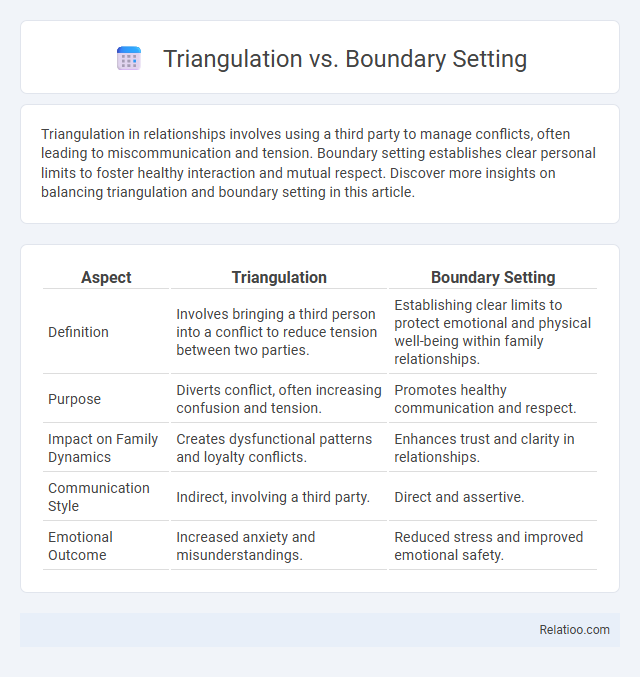Triangulation in relationships involves using a third party to manage conflicts, often leading to miscommunication and tension. Boundary setting establishes clear personal limits to foster healthy interaction and mutual respect. Discover more insights on balancing triangulation and boundary setting in this article.
Table of Comparison
| Aspect | Triangulation | Boundary Setting |
|---|---|---|
| Definition | Involves bringing a third person into a conflict to reduce tension between two parties. | Establishing clear limits to protect emotional and physical well-being within family relationships. |
| Purpose | Diverts conflict, often increasing confusion and tension. | Promotes healthy communication and respect. |
| Impact on Family Dynamics | Creates dysfunctional patterns and loyalty conflicts. | Enhances trust and clarity in relationships. |
| Communication Style | Indirect, involving a third party. | Direct and assertive. |
| Emotional Outcome | Increased anxiety and misunderstandings. | Reduced stress and improved emotional safety. |
Understanding Triangulation: Definition and Examples
Triangulation in communication occurs when a third party is involved to mediate or convey messages between two people, often leading to confusion or conflict. Understanding triangulation helps you recognize patterns where indirect communication replaces direct interaction, causing misunderstandings or emotional distance. Examples include a spouse confiding in a friend about marital issues instead of addressing the partner directly, which complicates conflict resolution and boundary clarity.
What is Boundary Setting? Core Concepts Explained
Boundary setting involves clearly defining personal limits to protect your mental, emotional, and physical well-being. Core concepts include identifying your needs, communicating them assertively, and enforcing consequences when boundaries are crossed. Understanding boundary setting helps prevent manipulation and maintains healthy relationships, unlike triangulation which often involves indirect communication or conflict through a third party.
Key Differences Between Triangulation and Boundary Setting
Triangulation involves involving a third party to manage or influence communication and conflict, often leading to indirect interactions and miscommunication. Boundary setting is the clear establishment of personal limits and expectations to protect emotional well-being and define acceptable behavior in relationships. Your ability to recognize the difference lies in understanding that triangulation creates dependency on external parties, while boundary setting empowers direct control over interpersonal dynamics.
Psychological Impact of Triangulation in Relationships
Triangulation in relationships creates confusion and mistrust by involving a third party to manipulate or control interactions, which can severely damage emotional well-being and communication. Boundary setting establishes clear personal limits that protect your mental health and foster respect, reducing the need for unhealthy third-party involvement. Recognizing and addressing triangulation helps break toxic patterns, promoting healthier, more transparent connections and emotional stability.
The Role of Healthy Boundaries in Emotional Well-being
Establishing healthy boundaries is crucial for emotional well-being, as it prevents triangulation, where indirect communication through a third party can create confusion and conflict. Clear, direct boundaries empower individuals to express needs and emotions effectively, reducing misunderstandings and maintaining trust in relationships. Prioritizing boundary setting fosters personal accountability and emotional resilience, essential components for mental health stability.
Common Scenarios: Triangulation vs Boundary Setting
In common scenarios, triangulation involves a third party to communicate or influence relationship dynamics, often causing misunderstandings and conflict escalation. Boundary setting establishes clear limits on acceptable behavior, protecting personal space and fostering respectful interactions. Both approaches address interpersonal challenges, but boundary setting promotes direct communication and healthier relationship management without involving outsiders.
How to Recognize Triangulation vs Boundary Setting
Recognizing triangulation versus boundary setting involves understanding intent and communication patterns: triangulation occurs when one person involves a third party to manipulate or avoid direct conflict, often causing confusion and divided loyalties. Boundary setting is a clear, respectful declaration of personal limits aimed at protecting your emotional well-being and fostering healthy relationships. Pay attention to whether interactions promote honesty and respect (boundary setting) or indirect, conflict-avoiding tactics (triangulation) to identify them accurately.
Strategies to Prevent Triangulation in Communication
Effective strategies to prevent triangulation in communication include establishing clear and direct boundaries that encourage open dialogue between parties involved, thereby reducing reliance on intermediaries. Encouraging assertive communication skills and promoting awareness of triangulation dynamics help individuals address conflicts directly without involving third parties. Training teams or families on recognizing triangulation patterns supports the development of healthier interaction habits and strengthens trust in relationships.
Effective Techniques for Setting and Maintaining Boundaries
Effective boundary setting involves clear communication of personal limits and consistent enforcement of those limits to maintain healthy relationships. Triangulation, which occurs when a third party is involved in conflicts or communication issues, undermines boundary integrity and should be avoided to preserve trust and clarity. Maintaining boundaries requires direct dialogue, assertiveness, and strategies to prevent triangulation-driven misunderstandings.
Triangulation or Boundary Setting: Which Approach to Use and When?
Triangulation involves using multiple data sources or perspectives to validate information, enhancing accuracy and reliability, while boundary setting establishes clear limits to protect personal space and emotional well-being. You should prioritize triangulation in research or conflict resolution scenarios where cross-verifying facts is essential, whereas boundary setting is crucial in personal relationships or professional environments to maintain respect and prevent burnout. Understanding the context and goals helps determine whether validating information through triangulation or enforcing limits through boundary setting is more appropriate.

Infographic: Triangulation vs Boundary Setting
 relatioo.com
relatioo.com